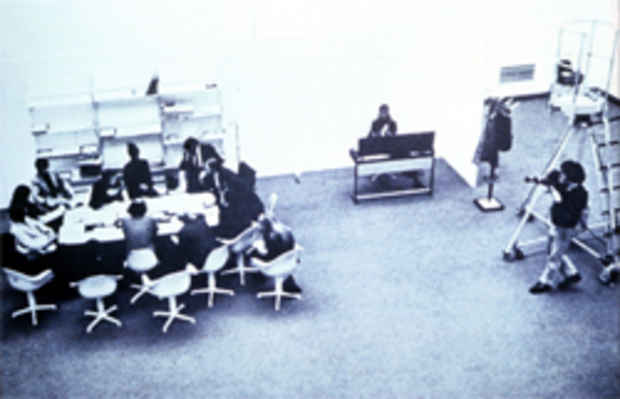"The Incidental Person" Exhibition
apexart

This event has ended.
The late British artist John Latham (1921-2006) coined the expression “the Incidental Person” in the context of Artist Placement Group, known as APG, which he co-founded in 1966 with Barbara Steveni, Jeffrey Shaw and Barry Flanagan. Contrary to most artist placement schemes, APG emphasized process, interaction and the artist’s independence in relation to the host institution, rather than any short-term tangible outcome. Like an unbiased observer or a third-party mediator, the Incidental Person placed through APG in industry, government, education or the non-profit sector would negotiate the terms of the invitation from the institution in question and adapt the nature of her or his intervention accordingly. This incidental function, as Latham explained, “is more to watch the doings and listen to the noises, and to eliminate from the output the signs of a received idea as being of the work.” Latham stresses the incidental person’s approach, that is, a certain position or attitude vis-à-vis the context in which she or he is placed. In other words, the identity of the incidental person is secondary to the effect she or he has on a given situation, for the aim of the incidental person is not to be anything in particular but instead “to generate maximum public involvement, and maximum enthusiasm which goes with the involvement.”
It is high time to pay renewed attention to incidentality as an effective approach to pressing societal issues. Away from the rudimentary right/left or liberal/conservative labels that paralyze governments and polarize communities, the incidental attitude is one of self-reflexiveness and acute, humble awareness of the complex networks of local pressures that inform a specific time and place. We like to assign tags to artists who engage with problematics that exceed the confines of the so-called “art world”, such as socially- or politically-engaged, relational, performative, etc. But these qualifiers only serve to quarantine the curious thinker-doer further from society at large, reinforcing the myth of the artist as exempt from participating in the “real world.” The incidental person, by contrast, sees no alternative between “art” and the activities that regulate social coexistence, such as talking, playing, eating, reading, teaching and listening. Indeed, “art” itself — as a word corresponding to a distinct class of objects or actions — dissolves, becoming just another term for the disposition of someone whose incidental relation to the context in which she or he intervenes is simultaneously internal and external: internal to the context’s unique dynamics, but sufficiently external to it to be able to see its relevance to broader questions of “life-practice” or “the everyday” (but such phrases, too, are merely expedient equivalents for something even more incidental).
In recounting the origins of APG, Barbara Steveni has said that the initial incident occurred when Robert Filliou and Daniel Spoerri, who were staying with her and John Latham to prepare an exhibition in London, needed some found material. Despite the late hour, Steveni offered to collect whatever she could find at an industrial site beyond the city limits. Sifting through debris while the factory was in full activity, she experienced a “eureka” moment, as she put it: “Why aren’t we here? Not to pick up buckets of plastic, but because there’s a whole life that we don’t touch. This is what people go on about — academics, artists, politicians — but they go nowhere near it.” This exhibition includes projects by people who attempt precisely to “touch” what is “out there”, who, while meticulously attentive to the context at hand, refuse to hew to such distinctions as art/non-art, art/life or art/politics.
Antony Hudek
© 2009
Media
Schedule
from January 06, 2010 to February 20, 2010
Gallery Talk: January 9, 3-4 pm.
Opening Reception on 2010-01-06 from 18:00 to 20:00
Artist(s)
Ron Bernstein, Raphaële Bidault-Waddington, Luca Frei, Will Holder, Marysia Lewandowska, Gianni Motti, Brian O'Doherty, Joachim Pfeufer, Keiko Sei, Barbara Steveni, Megan Francis Sullivan, Neal White, and faculty and students from Portland State University MFA Art and Social Practice Concentration: Katy Asher, Katherine Ball with Alec Neal and Matthew Warren, Jennifer Delos Reyes, Harrell Fletcher, Constance Hockaday, Ariana Jacob, Hannah Jickling & Helen Reed, Laurel Kurtz & Sandy Sampson, The Print Factory, Eric Steen, Michelle Swinehart, Lexa Walsh, Jason Zimmerman